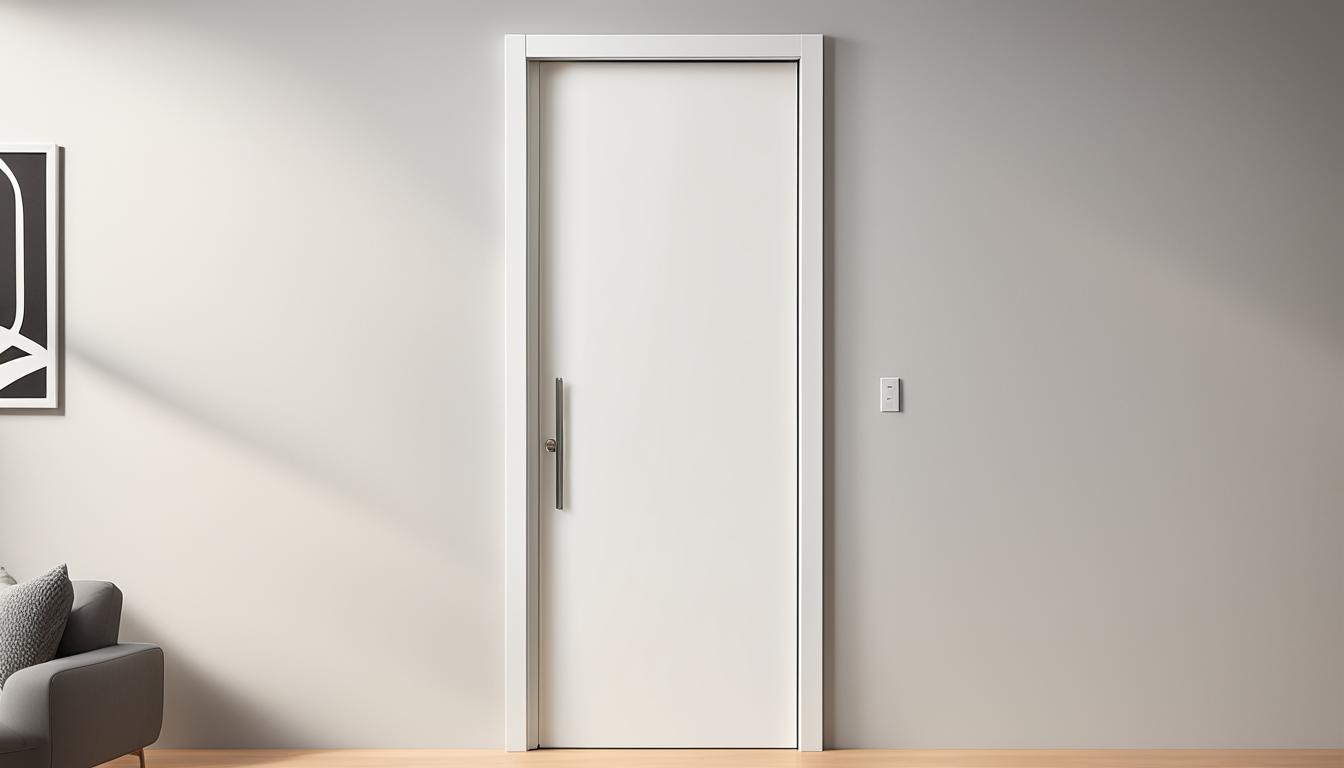Flush Door Vs Wooden Door: Best Choice for Your Home
When it comes to selecting the perfect door for your home, the options can be overwhelming. Among the various choices available, two popular options are flush doors and wooden doors. These doors not only serve as a functional entryway but also add to the overall aesthetics of your home interior. However, choosing the right door involves considering factors such as security needs and the desired look for your space.
In this article, we will explore the differences between flush doors and wooden doors, helping you make an informed decision for your home. We will dive into the raw materials used in their manufacturing, the thickness of the shutter, the available finishes, and more. We will also discuss the cleaning and maintenance requirements of each type of door, as well as their ability to protect against dust and provide strength. Additionally, we will examine their aesthetical appearance and applications, including the flexibility of design and materials offered by each option.
Lastly, we will provide a cost comparison between flush doors and wooden doors, allowing you to consider your budget while making a choice. By the end of this article, you will have a better understanding of which door is the best fit for your home interior and security needs.
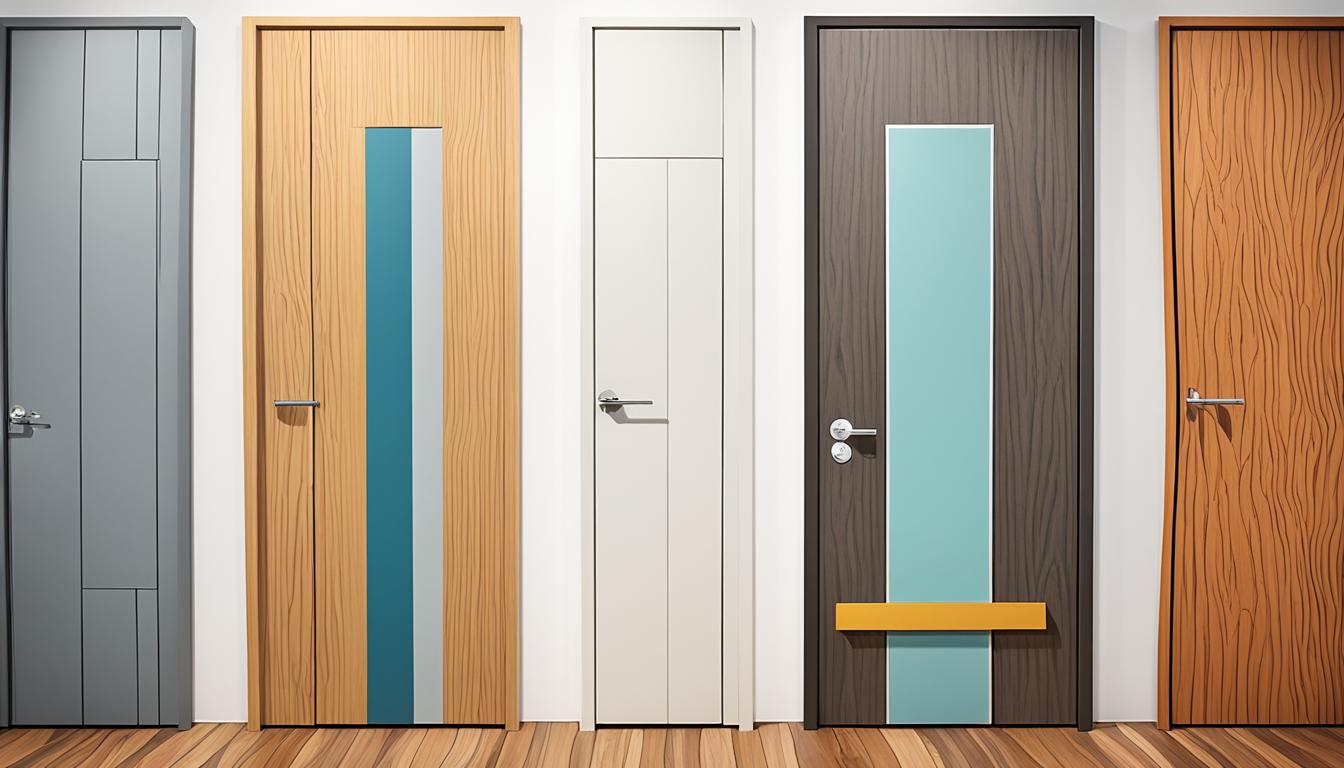
Key Takeaways:
- Flush doors and wooden doors are both popular choices for home interiors.
- Consider factors such as security needs and desired aesthetics when selecting a door.
- Flush doors are made using different raw materials and can have various finishes.
- Wooden doors offer a classic and natural look, with options for different wood types and finishes.
- Cleaning and maintenance requirements differ between flush doors and wooden doors.
Understanding Flush Doors
Flush doors are a popular choice for modern homes due to their sleek and minimalistic design. These doors are characterized by their smooth and flat surface, with no raised or recessed panels. They offer a seamless and clean look that blends well with various home interior styles.
The manufacturing of flush doors involves using high-quality raw materials to ensure durability and strength. Typically, the core of a flush door is made of hardwood or composite wood, such as particleboard or medium-density fiberboard (MDF). This core is then covered with a thin layer of veneer or laminate on both sides.
The thickness of the shutter is an important consideration when choosing a flush door. Standard flush doors usually have a thickness of 25 to 35 millimeters, while thicker options are available for enhanced insulation and soundproofing.
When it comes to finishing, flush doors offer a wide range of choices. They can be painted or stained to match the overall color scheme of your home. Additionally, they can be customized with various finishes such as glossy, matte, or textured surfaces, allowing you to achieve the desired aesthetic appeal.
Quote: “Flush doors are an excellent choice for those who prefer a clean and modern look. Their versatility in terms of design and finishing options makes them suitable for a wide range of home interior styles.” – Interior Designer, Jane Smith
Advantages of Flush Doors:
- Minimalistic and sleek design
- Durable and long-lasting
- Affordable
- Easy to clean and maintain
Disadvantages of Flush Doors:
- Limited design options compared to wooden doors
- Less effective in providing insulation and soundproofing
| Raw Material | Thickness | Finishing |
|---|---|---|
| Hardwood or composite wood core (particleboard or MDF) | 25-35 millimeters (standard), thicker options available for enhanced insulation and soundproofing | Painted, stained, glossy, matte, textured |
Understanding Wooden Doors
Wooden doors are a popular choice for homeowners due to their timeless appeal and natural beauty. These doors are crafted from various types of wood, each offering unique characteristics and aesthetic appeal. Let’s explore what wooden doors are, the raw materials used in their manufacturing, the thickness of the shutter, and the available finishing options.
What is a Wooden Door?
A wooden door is a door made primarily from wood, known for its strength, durability, and classic appearance. Crafted using a wide range of wood species, including oak, mahogany, pine, and walnut, wooden doors showcase the natural grain patterns and color variations of the chosen wood. They bring warmth and elegance to any home interior.
Raw Materials Used in Manufacturing
The manufacturing of wooden doors involves carefully selecting high-quality wood. Different wood species have varying properties that impact the door’s performance and aesthetics. Manufacturers use seasoned wood that has been dried and treated to enhance its durability and resistance to warping or shrinking. Common raw materials used in the manufacturing of wooden doors include:
- Oak
- Mahogany
- Pine
- Walnut
Thickness of the Shutter
The thickness of the door shutter plays a crucial role in determining its sturdiness and durability. Wooden doors are available in different thicknesses, typically ranging from 25mm to 40mm. Thicker shutters provide enhanced strength and security, making them ideal for exterior doors, while thinner shutters are suitable for interior doors, offering a balance between aesthetics and practicality.
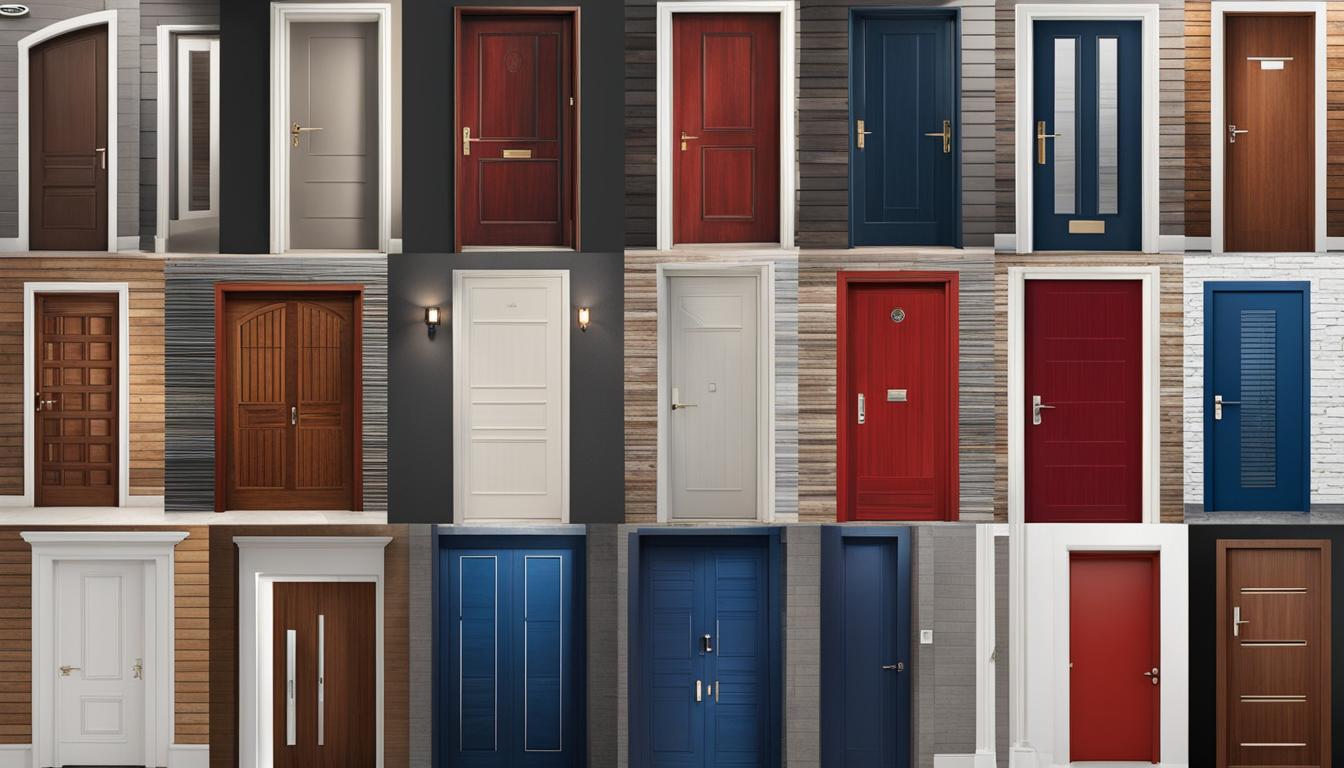
Finishing Options
Wooden doors can be finished in various ways to enhance their appearance and protect them from external elements. Popular finishing options for wooden doors include:
- Painting: Apply paint in a range of colors to match the home’s interior design.
- Staining: Enhancing the natural color and grain of the wood while still providing protection.
- Varnishing: Applying a clear coat to showcase the wood’s natural beauty and provide protection against moisture and wear.
- Polishing: Achieving a smooth and glossy finish using specialized wood polish products.
Each finishing option offers distinct visual effects and protection, allowing homeowners to personalize their wooden doors based on their preferences and interior design style.
| Raw Material | Characteristics |
|---|---|
| Oak | Durable and resistant to moisture |
| Mahogany | Rich, reddish-brown color and excellent durability |
| Pine | Lightweight, affordable, and easy to work with |
| Walnut | Dark, luxurious appearance with natural resistance to decay |
Wooden doors not only provide security but also add a touch of sophistication and elegance to any home. The choice of raw material, shutter thickness, and finishing options can further enhance the overall aesthetics and functionality of wooden doors.
Differences in Cleaning and Maintenance
When it comes to the cleaning and maintenance of flush doors and wooden doors, there are some notable differences to consider. Both types of doors require regular cleaning and upkeep to ensure their longevity and aesthetic appeal. Let’s explore the cleaning and maintenance aspects of each type of door:
Flush Doors
Flush doors are known for their smooth and seamless surface, which makes cleaning a relatively simple task. Here are some key points regarding the cleaning and maintenance of flush doors:
- Regular dusting and wiping with a soft cloth are usually sufficient to keep flush doors clean.
- For stubborn stains, a mild detergent mixed with water can be used to gently clean the surface.
- Avoid using abrasive cleaners or harsh chemicals, as they can damage the finish of the door.
- Periodically check the hinges and handles for any loose screws and tighten them if necessary.
- Inspect the door for any signs of damage or wear, such as cracks or warping, and address them promptly to prevent further issues.
Wooden Doors
Wooden doors require regular cleaning and maintenance to preserve their natural beauty and functionality. Here are some essential points to keep in mind when it comes to cleaning and maintaining wooden doors:
- Dust the wooden door regularly with a soft cloth or a gentle duster to prevent the buildup of dirt and debris.
- Use a mild wood cleaner or a mixture of vinegar and water to clean the surface of the door, following the manufacturer’s instructions.
- Avoid saturating the wood with water or using abrasive cleaners, as they can damage the finish or cause the wood to swell.
- Apply a protective coating or sealant to the wooden door periodically to maintain its luster and protect it from moisture and pests.
- Inspect the door for any signs of cracks, rot, or termite infestation, and address them immediately to prevent further damage.
Pros and Cons:
| Flush Doors – Pros | Flush Doors – Cons |
|---|---|
|
|
| Wooden Doors – Pros | Wooden Doors – Cons |
|---|---|
|
|
When considering the cleaning and maintenance aspects, it is important to weigh the pros and cons of each type of door to determine which option best suits your needs and lifestyle. Whether you opt for the easy maintenance of flush doors or the timeless beauty of wooden doors, regular care and attention will help keep your doors looking their best.
Protection from Dust and Strength
When it comes to choosing between flush doors and wooden doors for your home, it’s important to consider their ability to protect against dust and their overall strength. Let’s take a closer look at these factors and compare the two options.
Protection from Dust
Flush doors: These doors offer excellent protection from dust, thanks to their seamless construction. The absence of grooves or panel joints makes it difficult for dust to accumulate, making them a great choice for those looking for a low-maintenance option.
Wooden doors: While wooden doors may require more regular cleaning to prevent dust buildup in grooves and joints, they can still provide adequate protection from dust if well-maintained. Regular dusting and periodic polishing can help keep the doors looking clean and dust-free.
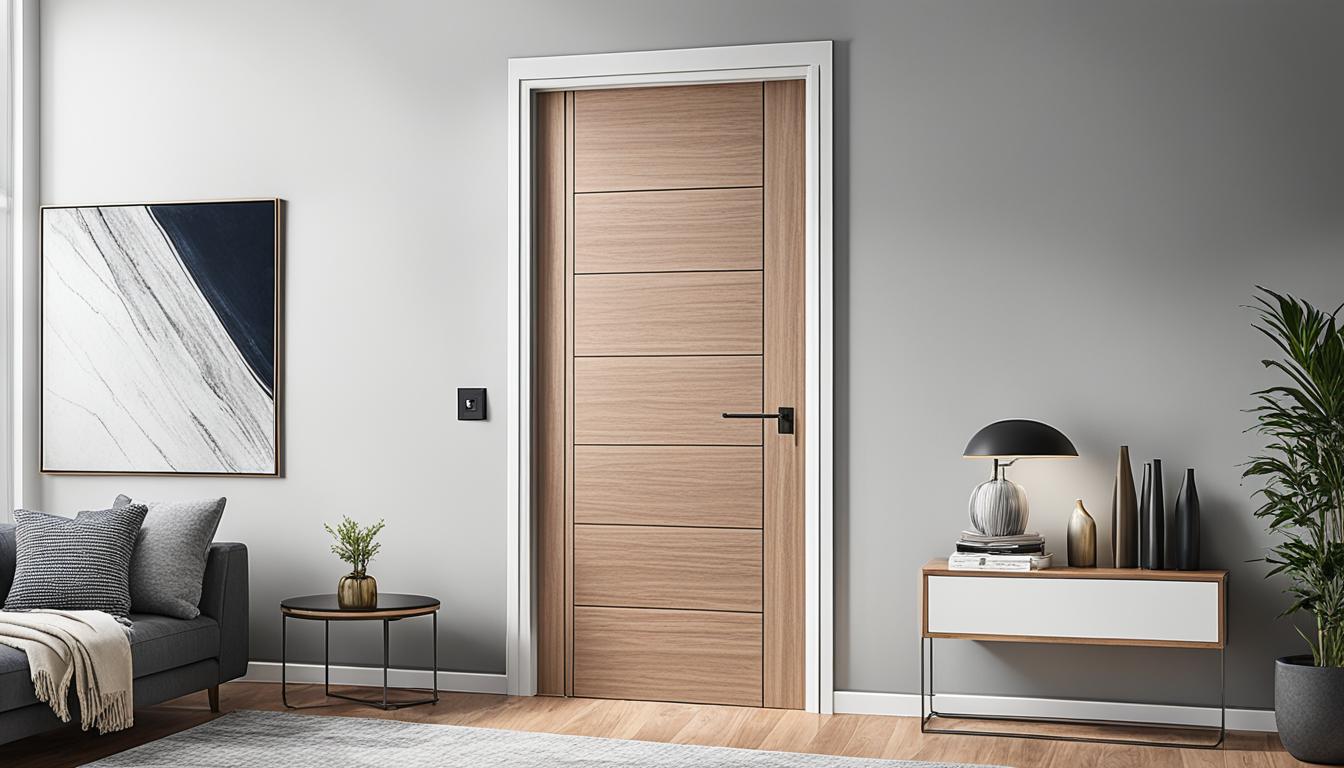
Strength of the Door
Flush doors: Flush doors are known for their strength and durability. Made from a solid core covered with layers of industrial-grade veneer, these doors can withstand everyday wear and tear, making them suitable for high-traffic areas.
Wooden doors: Wooden doors are also known for their strength, especially when made from sturdy hardwood such as oak or mahogany. They can offer excellent resistance to impacts and are a popular choice for those seeking a robust and secure door.
Overall, both flush doors and wooden doors provide reliable protection from dust and offer strength for different needs. Your choice will ultimately depend on your specific preferences, budget, and the desired aesthetic appeal for your home.
| Protection from Dust | Strength | |
|---|---|---|
| Flush Doors | Excellent | High |
| Wooden Doors | Good | High |
Aesthetical Appearance and Applications
When it comes to choosing the perfect door for your home, aesthetical appearance plays a crucial role. Both flush doors and wooden doors have their unique charm that can enhance the overall appeal of your space. Let’s take a closer look at their aesthetical appearance and the applications they are suitable for.
Aesthetical Appearance
Flush doors, with their sleek and minimalistic design, offer a contemporary and modern appeal to any room. They provide a seamless look, blending effortlessly with various interior styles. Their smooth surface allows for easy customization with different paints or laminates, giving you the freedom to match them with your existing decor.
On the other hand, wooden doors exude a timeless elegance and natural beauty. The wood grains and textures add depth and warmth to your space, creating a cozy and inviting atmosphere. Wooden doors come in various types of wood, such as oak, mahogany, or teak, each showcasing its distinctive character and richness.
“The flush door seamlessly complements contemporary interiors, while the wooden door adds a touch of timeless elegance to any space.”
Applications
The choice between flush doors and wooden doors depends on the specific applications within your home. Each type has its strengths and suitability for different areas.
| Flush Doors | Wooden Doors |
|---|---|
| 1. Residential interiors | 1. Traditional or rustic-themed homes |
| 2. Offices and commercial spaces | 2. Classic or vintage-inspired interiors |
| 3. Modern apartments | 3. Home entrances for a grand first impression |
| 4. Kitchen or utility areas | 4. Bedrooms for a cozy and intimate feel |
As seen above, flush doors are versatile and can be used in a wide range of settings, from residential interiors to offices and commercial spaces. They are particularly suitable for modern apartments and utility areas like kitchens.
Wooden doors, on the other hand, excel in traditional or rustic-themed homes, where their natural beauty can be fully appreciated. They also create a grand first impression when used as home entrances and add a cozy and intimate feel to bedrooms.
Ultimately, the choice between flush doors and wooden doors for various applications depends on your personal preferences and the overall design aesthetics you want to achieve in your home.
Flexibility of Design, Materials, and Shapes
When it comes to choosing the perfect door for your home, considering the flexibility of design, materials, and shapes is crucial. Both flush doors and wooden doors offer a wide range of options to suit your individual preferences and requirements.
Design Flexibility:
Flush doors provide a sleek and contemporary look that seamlessly blends with modern interiors. They are available in various finishes, including veneer, laminates, and paint, allowing you to customize them to your desired aesthetic. Wooden doors, on the other hand, bring timeless elegance and warmth to your home. They offer countless design possibilities, including intricate carvings, paneling, and decorative glass inserts, enabling you to create a unique and personalized entrance.
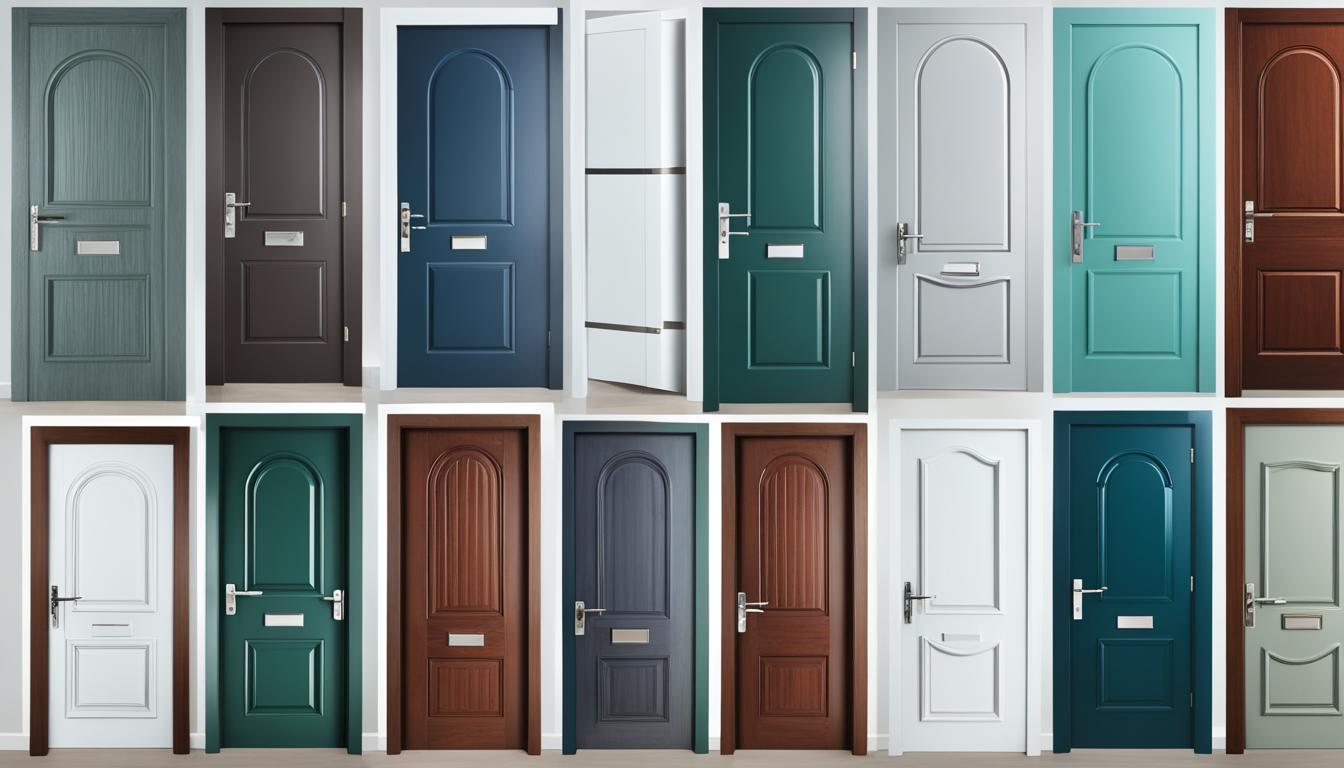
Material Options:
The flexibility of materials is another aspect to consider. Flush doors typically consist of a solid core or a hollow core filled with a lightweight material. This makes them lightweight and easy to install. On the other hand, wooden doors are crafted from various types of wood, such as teak, oak, or mahogany, each offering distinct characteristics and visual appeal. The choice between flush doors and wooden doors depends on factors like durability, insulation, and budget.
Shape Selection:
Both flush doors and wooden doors come in a variety of shapes, allowing you to find the perfect fit for your home. From traditional rectangular doors to arched or circular designs, there is a shape to complement any architectural style or personal preference. Whether you prefer a sleek and minimalistic look or a more ornate and intricate design, you can find a door that reflects your style.
By providing a wide range of design options, materials, and shapes, flush doors, and wooden doors ensure that you can find a door that not only enhances the visual appeal of your home but also meets your specific needs and preferences.
| Comparison of Flexibility | ||
|---|---|---|
| Aspects | Flush Doors | Wooden Doors |
| Design Options | Customizable finishes – veneer, laminates, paint | Countless design possibilities – carvings, paneling, glass inserts |
| Material Variety | Lightweight core materials | Different types of wood – teak, oak, mahogany |
| Shape Range | Available in various shapes – rectangular, arched, circular | Offered in diverse shapes – rectangular, arched, circular |
Cost Comparison
When choosing between flush doors and wooden doors for your home, one crucial factor to consider is the cost. Understanding the cost comparison can help you make an informed decision based on your budget and priorities.
“By comparing the costs of flush doors and wooden doors, homeowners can assess the financial feasibility of each option and determine the best fit for their needs.”
Let’s take a look at the cost comparison between flush doors and wooden doors:
| Factors | Flush Doors | Wooden Doors |
|---|---|---|
| Initial Cost | Lower cost range (depending on material and design) |
Higher cost range (depending on wood type and craftsmanship) |
| Installation Cost | Relatively lower installation cost | May require skilled labor for proper installation, leading to a higher installation cost |
| Maintenance Cost | Minimal maintenance cost due to durability | The potential cost for regular maintenance, such as polishing and refinishing |
| Lifespan | Generally offers a long lifespan | Requires periodic maintenance to ensure longevity |
It’s important to note that while flush doors may have a lower initial cost, wooden doors can provide a timeless and luxurious aesthetic. This can add value to your home in the long run.
Consider your budget, desired aesthetic, and the specific needs of your home before making a decision. Consulting with professionals in the industry can also help you navigate the cost options and find the best solution for your home.
Conclusion
After careful analysis, it is clear that both flush doors and wooden doors have their unique advantages and considerations to keep in mind. When deciding on your home, it is important to take into account your specific needs, including home interior and security requirements.
Raw material, thickness, finishing, cleaning, maintenance, and protection from dust are all factors to consider. Flush doors, with their sleek and modern appearance, are a popular choice for those seeking a contemporary look. On the other hand, wooden doors offer a timeless charm and can be customized to match various interior design styles.
Furthermore, while flush doors offer durability and strength, wooden doors provide a natural soundproofing effect, enhancing privacy within your home. Additionally, wooden doors offer a wide range of design options, allowing you to express your style.
Ultimately, the choice between flush doors and wooden doors will depend on your preferences, budget, and specific requirements. Consider the cost, flexibility of design and materials, shapes available, and overall aesthetic appeal. By carefully evaluating these factors, you will be able to select the best door option that suits your home’s interior and security needs.
FAQ
What is a flush door?
A flush door is a type of door that has a smooth and flat surface on both sides. It is constructed using a solid core material, such as particleboard or solid wood, enclosed by veneers or other laminates.
What is a wooden door?
A wooden door is a type of door that is primarily made from wood. It is constructed using solid wood panels or frames and may have decorative elements or intricate carvings.
What are the key differences between wooden doors and flush doors?
Here is a comparison based on various aspects:
| Parameters | Wooden Doors | Flush Doors |
|---|---|---|
| Raw Material | Primarily wood | Wood or particleboard core with veneers or laminates |
| Thickness of the Shutter | Thicker than flush doors | Thinner than wooden doors |
| Finishing | Various options are available, including paints, varnishes, and stains | Multiple finishes available, such as laminates and veneers |
| Cleaning and Maintenance | May require regular polishing and refinishing | Relatively easier to clean and maintain |
| Pros | Natural and traditional look, durable, better insulation | Smoother appearance, cost-effective, resistant to warping and cracking |
| Cons | Prone to termite attacks, can be expensive | Less soundproof, limited design options |
| Protection from Dust | May allow dust particles to settle on the surface | Minimal gaps reduce dust accumulation |
| Strength | Generally more solid | Solid core provides strength and stability |
| Aesthetical Appearance | Classic and timeless look | Contemporary and minimalist design |
| Applications | Suitable for traditional and rustic interiors | Ideal for modern and sleek interiors |
| Flexibility of Design and Materials | Can be customized with intricate carvings and different wood types | Offers more design options with veneers and laminates |
| Shapes Available | Limited to standard door shapes | Available in various shapes and sizes |
| Cost | Can be expensive, especially with high-quality wood | Relatively cost-effective, suitable for budget-friendly projects |
Thanks For the Great Attention!
Also, Read,
What are Flush Doors and Types of flush doors
3 Different types of Flush doors


